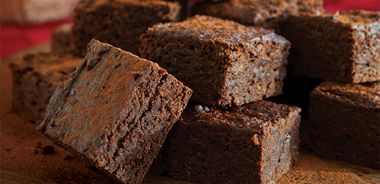Mocha Date Brownies

Really fudgy and chocolatey with a hint of coffee and some orange to round out the flavour. Delish.
1 1/2 cups (350 mL) whole dates
1 cup (250 mL) fresh orange juice
1 Tbsp (15 mL) vanilla extract
2 large free-range eggs
1/2 cup (125 mL) cocoa
1 1/2 tsp (7 mL) espresso powder
1/2 tsp (2 mL) baking powder
1/2 tsp (2 mL) salt
1/2 cup (125 mL) unsalted butter
1 cup (250 mL) all-purpose flour
1 cup (250 mL) chocolate chips
Preheat oven to 325 F (160 C).
Simmer dates with orange juice until very tender. Stir in vanilla. Purée to a smooth paste.
Line 8 x 8 x 2 in (20 x 20 x 5 cm) square baking pan with parchment paper.
In large bowl, whisk eggs with cocoa, espresso powder, baking powder, and salt.
In saucepan, melt butter. Add date purée and stir often until warm and bubbly. Scrape mixture into bowl with cocoa mixture. Gently fold in flour and chocolate chips.
Spoon batter into pan and smooth top. Bake just until set, 30 to 35 minutes. Cool completely, and then cut into squares.
Makes 16 brownies.
Each serving contains: 207 calories, 4 g protein;
11 g total fat (7 g sat. fat, 0 g trans fat); 29 g total carbohydrates (17 g sugars, 4 g fibre); 85 mg sodium
source: "Make It a Date!", alive #374, December 2013




